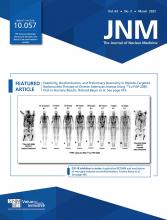TO THE EDITOR: We read with great interest the article by Dr. Yusufaly and colleagues (1), who developed a radiomic model incorporating tumor radiomic features, nontumor radiomic features, and clinical variables to predict disease recurrence in patients with cervical cancer. To the best of our knowledge, this was the first study to suggest that nontumor radiomic biomarkers derived from the whole body (including bone, fat, and muscle) could improve prognostic modeling of cancer. Previous studies have proven that peritumoral radiomic features could improve the performance of radiomic models (2–4). This study provides more comprehensive insights into the tumor and the immune state of the human body.
Despite the encouraging results, several methodologic issues should be noted. First, we are concerned about the workflow of the radiomic analysis. Although this study evaluated its radiomic quality score of 18 points (total points of 36), 2 domains were not truly conducted, that is, detection and discussion of biologic correlates and potential clinical utility. Although this study hypothesized that whole-body radiomic features may be associated with immune system function and could reflect variation in patients’ global inflammatory state, it did not investigate the biologic meaning behind radiomic features by correlation with computational pathology features, radiology–pathology coregistration, or analysis of biologic pathways or genomic correlations (5). In addition, an assessment of potential clinical utility through statistical methods such as decision curve analysis was not performed. Second, the current feature selection is not enough despite the fact that the authors manually excluded several highly correlated features; more sophisticated and rigorous dimensionality reduction methods (such as intraclass correlation analysis and Pearson correlation coefficient analysis) must be implemented to ensure the reproducibility and independence of the identified radiomic features (6). Third, this study applied only C-index as a discrimination metric for evaluating the predictive performance of radiomic models, but this metric is not enough, as calibration is not fully captured by C-index. Calibration statistics such as calibration plots, which reflect the consistency between the true probability and the predicted probability, are needed (7). Both discrimination and calibration statistics are recommended when evaluating the performance of models. Fourth, use of the cindex.comp package and net reclassification improvement is recommended for pairwise comparisons of model performance. Fifth, given the distinct prognosis between early-stage and advanced-stage tumors, the risk stratification determined by radiomics may be confounded by tumor stage; a subgroup analysis by stage can be considered to identify the true effect of radiomics. In addition, Figure 6 showed the same hazard ratios in the models based on stage plus tumor-related biomarkers and the model based on all biomarkers, suggesting that whole-body biomarkers failed to provide additional information for risk stratification. Finally, as the authors acknowledged in the limitations, the radiomic model was developed and validated at a single small center; multiple external validations would be beneficial for more generalizability to heterogeneous groups of patients regardless of the clinical setting.
Despite the above-mentioned limitations, we still appreciate Yusufaly and colleagues for their outstanding work on nontumor radiomic biomarker analysis, which provides a more holistic model. We look forward to further works to improve the validity and generalizability of their radiomic models.
Footnotes
Published online Dec. 16, 2021.
- © 2022 by the Society of Nuclear Medicine and Molecular Imaging.
REFERENCES
- Revision received November 3, 2021.
- Accepted for publication November 16, 2021.







